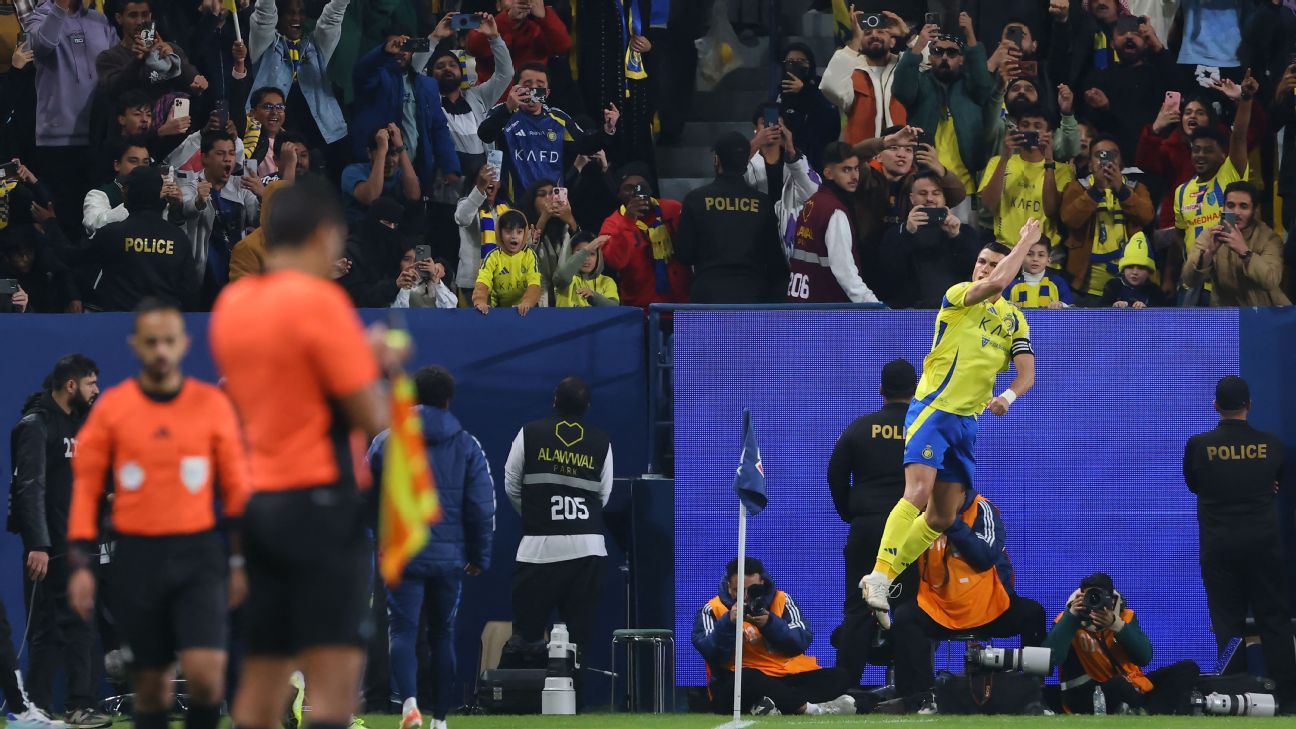CLEVELAND — Up close, the front and back of Babe Ruth’s faded, gray flannel New York Yankees jersey is peppered with stains. A felt, navy “NEW YORK” arches across the front, a lone No. 3 is affixed on the back. The name “Ruth G.H” is embroidered in red thread inside the collar. Earlier this year, a process that matches archival photographs with those details was used to pinpoint the jersey to Game 3 of the 1932 World Series — Ruth’s legendary “called shot” game — and set it on course to break the record paid for a sports collectible.
Advertised by Heritage Auctions as the “1932 Babe Ruth Game Worn New York Yankees World Series ‘Called Shot’ Jersey,” bidding for Lot No. 80162 opened at $7.5 million and on Friday stood at $15.1 million — and with a standard 20% buyer’s premium, the amount is $18.12 million. The auction is scheduled to close Sunday.
Chris Ivy, director of sports auctions for Heritage Auctions, which is brokering the sale, told ESPN in May that he wouldn’t be surprised if the Ruth jersey exceeds $30 million. In July, at the 44th National Sports Collectors Convention in Cleveland, Ivy said the amount could rise even beyond that area.
The anticipated sale price of the jersey, which previously sold at auction in 2005 for $940,000, has skyrocketed amid a game-used memorabilia market boom fueled by an authentication process called photo-matching. Long used for art and collectibles such as vintage guitars, the use of photo-matching for game-used memorabilia — attempting to match idiosyncratic details of bats, jerseys, cleats or other objects according to details seen in historical photos — can significantly increase the market price.
A Babe Ruth bat that wasn’t photo-matched sold with Heritage for $400,800 in 2018. Last year, Henry Yee, a photo expert with Professional Sports Authenticator (PSA), a card grading company and autograph/memorabilia authenticator, matched the bat to photos from 1921, when Ruth set single-season and career home run records. It soon sold for $1.85 million with Hunt Auctions, still a record for a baseball bat.
In 2021, 44% of the 25 most expensive pieces of memorabilia were photo-matched, according to Altan Insights, a company that provides data and quantitative analysis to help investors understand the collectibles market. By 2023, the figure rose to 92%. Across sports collecting, the growth of and reliance upon photo-matching has mirrored an industry trend toward acquisition of game-used items. Experts say photo-matching isn’t just a convenient step beyond verification or a tool that leads to higher auction yields. In an industry rife with fraud, they say it’s a necessary measure, giving prospective buyers a greater degree of confidence in the authenticity of items they’re seeking to purchase.
But the process of photo-matching has limitations, and companies don’t always agree on what their teams see. Even for the Ruth jersey, one company did not definitively photo-match the item.
So how does photo-matching work and how foolproof is the process? Top-dollar memorabilia usually is authenticated and matched by multiple companies, often competitors. What if they disagree? Those are the kinds of questions that have surfaced around the Ruth jersey auction — and the stakes are high, as collectors attempt to navigate a shifting sports collectibles market that industry analysts project could reach into the hundreds of billions within the next decade.
PHOTO-MATCHERS CLOSELY examine unique markings such as stitching, fabric frays, stains or imperfections on memorabilia, comparing those details against archive photos in an effort to pinpoint where the item was used and its significance.
Companies such as Resolution Photomatching rely on checks and balances. People hired to do the job train four to six weeks before working on a single item, and they use a three-round system: one researcher utilizes databases to screen images that might include the item; another checks those flagged images; a third makes a call. Resolution often pores through tens of thousands of images per photo-match.
“The IRS doesn’t have photo-matching as a [job] classification yet,” said John Robinson, owner and founder of Resolution, “so their official classifications are ‘historians.’ One of our researchers’ young daughters called him a ‘sports history detective.’ That might be the best description.”
In the case of the Ruth jersey, as with other sports memorabilia on the market, provenance plays a vital role in verifying an item’s authenticity. In the early 1990s, a woman in Port St. Lucie, Florida, called Grey Flannel Auctions about a jersey she had found in a safe deposit box with “Ruth G.H” sewn on its collar. Ruth was a fixture on Florida golf courses after retiring in 1935. After a round with the woman’s father, Ruth purportedly ceded the jersey.
It was sold privately twice as a 1930s road Ruth jersey before a public auction with Grey Flannel in 2005 more definitively pinned it to the 1932 World Series. The description noted: “Not one of these experts can definitively say that it is not Babe Ruth’s 1932 World Series jersey.”
That year’s World Series between the Yankees and the Chicago Cubs became famous for Ruth’s supposed “called shot,” which occurred during the fifth inning of Game 3. With the score tied 4-4, Ruth stepped to the plate at Wrigley Field and pointed; whether he intended to point at pitcher Charlie Root, to the Cubs’ dugout or to the outfield remains a historical uncertainty. But on a Root curveball, Ruth hit a home run an estimated 440 feet to center.
“There wasn’t anything ironclad that definitively linked it to the ‘called shot’ until recently,” Ivy said. “A lot of information has come out in the last 20 years — new imagery, footage, photographs — things that could be used to potentially make that connection. Authentication is extremely important.”
Ivy confirmed that a New Jersey man bought the jersey in 2005 and kept it until now.
“But we don’t want to just rely on our in-house experts,” he said. “We want impartial third parties to evaluate the material — not only because we stand behind everything we sell, but the more confidence bidders have, the more they’re willing to bid.”
In a 2024 letter registering the Ruth jersey photo-match, MeiGray Authenticated said the jersey was photo-matched to two Getty Images pictures and a photo from the Chicago Daily News “showing Ruth standing at the dugout with Lou Gehrig and Joe McCarthy.” The letter said the photos were taken Oct. 1, 1932, before and during Game 3 of the World Series at Wrigley Field in Chicago.
The authentication company PSA grades on average 40,000 cards a day and boasts roughly a 75% market share. In February, PSA began offering photo-matching within PSA/DNA, its memorabilia authentication division. According to PSA president Ryan Hoge, the Ruth jersey is PSA’s first photo-matched object to come to auction.
Steve Stindt, general manager of PSA/DNA, said provenance goes only so far.
“You can have a nice letter from somebody’s great grandpappy who got the jersey from so-and-so and it’s been in their family, right?” Stindt said. “At the end of the day, it’s not a court of law. [Photo-matching] is definitive, collectors have been asking for it and it’s good business for us. We’re showing the item in our hand, taking an image of it, spotting it in a photograph of the player wearing that same item, pointing out unique characteristics in each.”
Having a legitimate photo-matching service was a direct response to the recent growth of the game-used market, according to Stindt. The photo-matching process isn’t in lieu of verification, it’s a step beyond, Hoge said: “Yes, it’s real … and here’s why we think it is tied to a specific game or event.”
On top of image libraries it has access to, PSA boasts a catalogue of thousands of previously authenticated original photographs. MeiGray, which said it has a contract with Getty Images, offers a lifetime warranty and letter of authenticity for items. The company has provided photo-matching for three of the top five game-used memorabilia sales ever.
“This jersey [as reported prior] is supposed to be from the ’32 Series, so that’s where we started,” said Jim Montague of MeiGray’s authentication team. “We researched seasons before, seasons after to make sure we’re seeing unique differences.”
The company looked into how many uniforms the New York Yankees ordered, said Barry Meisel, president and COO of MeiGray.
“The Yankees ordered three road grays and three home whites over an entire year, carried one over into the following year,” Meisel said. “[We looked at] the nuances of where the manufacturer — in this case, Spalding — put its company tag. This is a road gray, so, it doesn’t have pinstripes. So you determine: Could this have been worn in ’32? Where are the buttons placed, the placket? Where’s the Y stitched?”
How the “Y” was positioned in the front of the jersey in relationship to the buttons and placket was unique, Montague told ESPN in May. Thanks to archival photographs, MeiGray had a Game 3 close-up that revealed “little nuances in the ‘N’ that also stood out.” It also sourced photographs from Chicago newspapers and museums.
“There’s a small little notch, almost where the ‘N’ wasn’t completely straight [and] the top of the ‘W’ had this curve as opposed to a flat edge — other images, we saw a flat edge,” Montague said. “The ‘E’ had this bend in it at the bottom of it that was sort of different. [There] were seamstresses stitching the names, numbers, the names in the collar, all by hand. They’re not doing it the same two times in a row [so] all these things together lined up, had us very confident this was the shirt.”
Ivy and Heritage took the jersey to Wrigley Field, where Cubs players and employees viewed it. Ivy said Cody Bellinger and Drew Smyly were particularly curious about the photo-matching process.
“They thought the fat strap was interesting,” Ivy said. “How the jersey had straps to keep it tucked in while Ruth was playing.”
MeiGray provided approval on the Ruth jersey in April. Another company, End-to-End, had photo-matched it in 2022. (End-to-End was founded by Blake Panarisi, who became PSA’s photo-matching lead in February; PSA also photo-matched the Ruth jersey in May.) But on the eve of the collectibles conference in Cleveland in late July, the media site cllct.com reported controversy over the Ruth jersey. Its owner had submitted it to Resolution Photomatching three times with a “no match” result.
Resolution published a statement that read, in part, that it was the first company to research the jersey in 2019, and that the jersey was resubmitted in 2021 and 2022. “We would have loved nothing more than to have been able to call the jersey a ResMatch,” the statement read. “We passed up a very significant amount of money” in not doing so. The statement did note promising signs and that some characteristics of the jersey seemed to be “approximately the same” as in images, but there wasn’t enough for a match.
Robinson, the owner and founder of Resolution, said that for the company to photo-match an item, it “must see characteristics that are definitively identical and definitively unique.
“While we are always incentivized to make a ResMatch determination,” Robinson said, “we are unwavering in those criteria no matter the magnitude of the piece. In the situation with that piece, it is the latest of many examples that Resolution has the highest standards in photo-matching.”
Resolution works with Heritage often. A Walter Johnson jersey that hadn’t been photo-matched sold at auction for $352,000 in 2006. In May, Resolution pegged the jersey to a game from April 29, 1920, the first time Johnson faced Babe Ruth in a Yankees jersey. The jersey sold for $2.01 million. A not-photo-matched Magic Johnson jersey, circa 1980-85, sold for $10,285 with Infinite Auctions in 2019. Two years later, Resolution matched it to the clinching Game 6 of the 1980 NBA Finals and it sold for $1.5 million with Heritage. A 1958 Mickey Mantle jersey, which sold for $240,000 in 2021 before photo-matching, resold last August for $4.68 million with Heritage, making it one of the most expensive sports jerseys ever, after Resolution matched it to the 1958 season, including Opening Day.
“If that company had reasons that it did not believe that our work was accurate, it would have raised them,” Meisel said. “It did not. I don’t know if that company had all of the research we had. I respect everybody’s work, but in this case, we stand by our photo-match 100%.”
Heritage has provided documentation for Ruth bidders, including an April 2019 letter from Resolution to the New Jersey consignor stating: “In our opinion, the alignment of the buttons and seam with the custom stitched ‘Y’ in the ‘New York’ lettering on the front of the jersey appear to be approximately the same on the jersey worn by Ruth in multiple images analyzed as compared to the jersey presented to us.”
SOME OF THE most famed and expensive pieces of sports memorabilia, including autographed items, are steeped in muddy waters. Ruth, with his stature and the historical significance of his items, has been among the sports industry’s most forged. His secretary also signed for him.
Fraud can be difficult to spot, and advances in technology and the use of artificial intelligence have raised the prospect of additional challenges.
“I wouldn’t say they’re using AI yet, but eventually they will, it’s going to happen in every aspect of our lives,” said James Spence III, vice president of James Spence Authentication (JSA). “Right now, [forgers] are programming signatures into auto-pen machines. These machines have existed for well over 75 years, astronauts had them, presidents used to have them, major political figures — they would basically sign fan mail and mass quantity signatures.”
Brian Dwyer, president of Robert Edward Auctions (REA), said the company does vetting on the front end before items are even consigned.
“Sometimes when we take in memorabilia, it isn’t a question of if it’s real or not, it’s, ‘Has it been restored? Is there something hidden? Is there a repair?'” Dwyer said. “[That’s why] photo-matching is an exciting part of the hobby, still in the early stages. As these companies utilize technology, as more archives become available and the process gets refined, we’ll unlock a whole new realm of secrets.”
JSA, owned by grader and authenticator Certified Collectibles Group, doesn’t use AI to verify or match yet, but Spence and other authenticators say it’s imminent.
A representative from the FBI’s art crimes team said the agency works with authenticators and auction houses to identify problems such as forgery early, but with the boom in collecting, the potential for fraud follows. The FBI told ESPN that consumers have to put the kind of research into collectibles that they do when buying a house or car.
WITH GROWTH IN the game-used arena and projections that the collectibles market will hit hundreds of billions, business owners such as Michael Rubin, founder and CEO of Fanatics, are buying companies like Topps and auction arms like PWCC Marketplace, which has been rebranded as Fanatics Collect.
“We only started selling trading cards 2½ years ago,” Rubin said, with NBA and NFL trading card rights imminent in 2025 and 2026, respectively. “I’m going to do this for the rest of my life, so we’ve got many decades to do this.”
Ken Goldin, founder of collectibles marketplace Goldin and star of the Netflix show “King of Collectibles,” said photo-matching enhances an item’s value beyond getting something directly from an athlete.
“Take a [game-used] Michael Jordan Chicago Bulls jersey and it comes with, say, third-party authentication — not photo-matched — maybe that jersey is $30,000 [to] $50,000,” Goldin said. “Let’s say you have a letter from Jordan’s teammate who says, ‘I was handed this jersey personally by Michael after a game,’ and it’s a trusted teammate? That’s going to add 50% to 75% to the value. But if you took that jersey, with the authentication, the letter, and photo-matched it to a specific game? It almost doesn’t matter what game it is. Jordan could’ve scored 16 points or they lost … it’s instantly a $500,000 jersey.”
Collector Rob Gough, who purchased a 1952 Topps Mickey Mantle card for a then-record $5.2 million in January 2021, said he has shifted his focus and spent nearly $30 million on game-used memorabilia in the past year.
“Photo-matching is extremely important,” Gough said. “I want [items] matched, ideally by multiple companies, too.”
Gough bought Wilt Chamberlain’s rookie year uniform; the jersey Wayne Gretzky scored his final point in; a Kobe Bryant jersey from Game 1 of the 2010 NBA Finals, his last; Victor Wembanyama’s first NBA jersey from summer league. Gough notes that Heritage has a 1951 game-worn Jackie Robinson jersey up for auction, currently at $2.82 million.
“But it’s not photo-matched,” Gough said. “So, for me, it’s just a nonstarter. I’m out.”






